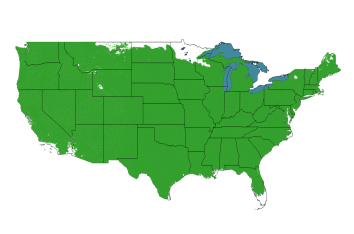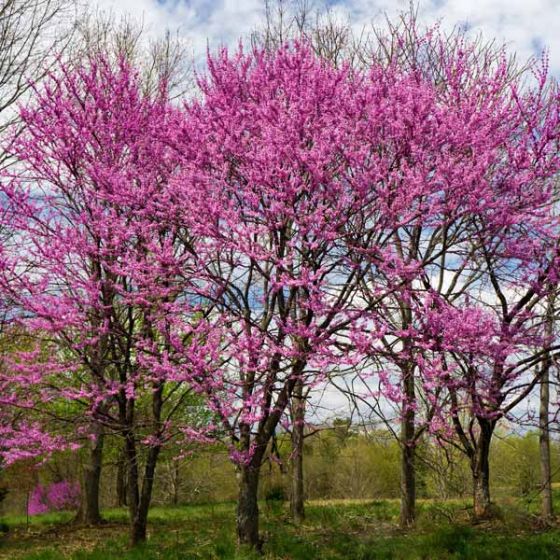✖
Eastern Redbud
Cercis canadensis
As low as
$94.92
In stock
SKU
PFY-315
Electric Pink-Purple Flowers Eastern Redbud Tree
- Showy Flowers in Early Spring
- Native Tree
- Widely Adapted and Easy to Grow
- Disease Resistant
- Beautiful Small Flowering Tree
- Mellow Fall Color
- Winter Interest
Plant Eastern Redbud (Cercis canadensis) as an outstanding clarion call to herald the arrival of spring. Use this lovely native tree by itself as a specimen focal point or plant several to create a spectacular grouping.
This tree steals the show each spring. Electric, lavender-pink clusters of blossoms burst from the bare branches, long before any of the heart-shaped leaves emerge. Every branch is festooned with flowers!
The stunningly delightful presentation lasts for weeks in the spring! Garden designers rely on Eastern Redbud's flower power. They use this tree as the main attraction in the Spring Garden. Why not follow their lead?
This small, ornamental tree is a great choice. Native to most of the United States in one species or another, they are easy care. They also bring many desirable features into the landscape.
New leaves unfurl underneath the flowers and grow into a perfect heart-shape for summer shade. Held on long petioles, they'll flutter and dance in a charming way whenever a breeze blows through them.
As fall comes on and the nights get colder, the foliage mellows into a nice shade of harvest yellow. Tiny, purplish seed pods dangle and persist for a bit of textured winter interest.
Versatile Redbuds have a unique, sculptural shape that can vary from tree to tree. There are many ways to feature them throughout the landscape, and they make a natural partner for water features and woodlands.
Eastern Redbud is native to North America where it grows in woodlands and along creeks and rivers. It's primarily found as an understory tree growing along with taller hardwoods and conifers, so it can tolerate partial shade conditions.
Being native to the Americas and found naturally from Texas to the Great Lakes, the Eastern Redbud has super soil adaptability. It thrives in nearly any condition and grows about 2 feet a year until maturity.
These popular springtime superstars sell out every year. Order your Eastern Redbud trees now!
How to Use Eastern Redbud in the Landscape
Grow the Eastern Redbud as a single specimen tree or as a small grove of 3 to 5 for a great woodland effect. When happy, these trees are very little maintenance and naturalize in the landscape beautifully.
They'll appreciate well-drained soil but are tolerant of wet conditions. This makes them perfect to use in a lawn setting. They won't mind the regular application of water required by turf.
Move into an established yard with a large evergreen tree? Plant an Eastern Redbud nearby to boost the appeal. Add a planting bed to the east, south or west of the larger tree and create a special spring display.
You'll love the contrast between the fluorescent Redbud flowers and the steady tones of the evergreen foliage. Mulch it and underplant with spring bulbs, small evergreen shrubs and a few summer flowering shrubs to create a year-round display.
These are a great choice for both home garden, and commercial plantings. They'll do very well in median parking strips. Use them as street trees along walkways or in park settings.
As you can imagine, Eastern Redbud is a premier choice for native landscapes or native restoration projects. Include them in your garden border plantings or marching along property lines.
For a large hedge where the canopies touch, plant them 6 - 8 feet apart on center. You'll measure from the center of one to the center of the next. Expand that spacing from 10 - 12 feet apart to establish individual trees.
Train the Eastern Redbud as a single trunk tree or buy a multi-trunk clump for a more natural look. Try one at the corner of your house to anchor your foundation planting.
Use 2, 4 or 6—however many you have room for—on either side of a driveway to create a magnificent allée. What a treat in spring!
We aren't sure if there is anything prettier than an Eastern Redbud in full bloom at the edge of a pond or water feature. Why not plant them with slightly tilted trunks, so that the canopy appears to reach towards the water?
#ProPlantTips for Care
Plant Eastern Redbud in well-drained soil. Give them plenty of regular water, especially when young and in drier climates.
In western hardiness Zone 9, Eastern Redbud benefits from morning sun and protection from the hot afternoon sun. In the hotter climates, give the Eastern Redbud plenty of mulch. Use at least 4 inches of wood chips spread to 3 feet outside of the canopy of the tree.
Be patient with young trees. Oftentimes, they are slow to send out leaves in spring, so give them time.
Eastern Redbud is one of our prettiest native trees. You'll love the look of the bare branches clothed in great clusters of early spring blossoms. Order yours today!
| Botanical Name | Cercis canadensis |
|---|---|
| Mature Height | 20 - 30 feet |
| Mature Spread | 15 - 30 feet |
| Soil Type | Well Drained |
| Moisture | Moderate |
| Sun Exposure | Full Sun, Partial Shade |
| Growth Rate | Fast |
| Bloom Period | Early Spring |
| Flower Color | Pink, Purple |
| Foliage Color | Green |
| Fall Color | Yellow |
| Pollinator Required | No |
| Pollinator Friendly | Yes |
| Growing Zone Range | 4-9 |

Write Your Own Review

